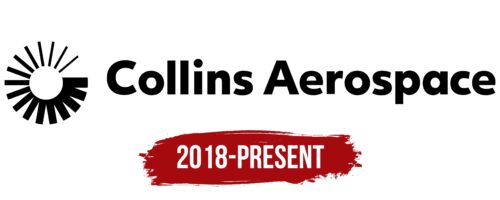Collins Aerospace’s logo resembles an accelerating mill or running wheel download. The drawing connects the company with the theme of movement and flight. The emblem looks like it is picking up speed and ready to take to the air along with airplanes and rockets.
The aerospace supplier uses a black-and-white logo consisting of two parts: a circular symbol and an inscription. The graphic image resembles a load indicator, which can refer to electronic components in technology. This element looks like a spring coiled in a circle. Next is the phrase “Collins Aerospace,” written in a neat geometric sans-serif font similar to SoftMaker’s Montreal Serial Xbold.
The choice of a black-and-white color scheme speaks of professionalism and is generally considered universal across various media. The round symbol, reminiscent of a boot indicator, refers to electronic components and introduces an element of dynamism. The clean geometric font gives the logo a modern and streamlined feel, keeping with the cutting-edge nature of the aerospace industry.
Collins Aerospace: Brand overview
The history of Collins Aerospace began in 1933 when Arthur Collins founded the Collins Radio Company. Initially, the company operated from the basement of the Collins family home in Cedar Rapids, Iowa. A radio enthusiast, Arthur Collins started by producing shortwave radio transmitters for Admiral Richard Byrd’s Antarctic expedition. This initial order set the stage for the company’s future growth.
During World War II in the 1940s, Collins Radio Company expanded significantly, becoming a vital communication equipment supplier for the United States Armed Forces. The company gained valuable experience in aviation electronics by developing and manufacturing transmitters for military aircraft and ships.
In the 1950s, Collins Radio made strides in aviation electronics by creating the first integrated avionics system for commercial aircraft, improving navigation and flight safety. The company secured a contract 1955 to develop communication systems for the Mercury program, the first American manned spaceflight initiative.
Throughout the 1960s, Collins played a pivotal role in the US space program, providing equipment for the Mercury, Gemini, and Apollo missions. Notably, the iconic words of Neil Armstrong during the moon landing were transmitted through a Collins communication system. Concurrently, the company continued expanding its aviation business, supplying commercial and military aircraft avionics.
In 1971, Collins Radio faced financial challenges due to the scaling back of the US space program and economic downturn. To overcome this, the company sought solutions and was acquired by Rockwell International in 1973, which injected the necessary financial resources for further development. Following the merger, the company was rebranded as Rockwell Collins. Rockwell Collins solidified its position in avionics and communication systems in the following decades, developing advanced military and commercial aircraft technologies.
In 2001, Rockwell Collins became an independent publicly traded company focused on aviation electronics and communications. Subsequent acquisitions, such as SEOS Displays Limited in 2008 and ARINC Incorporated in 2013, expanded the company’s aviation training systems and network solutions capabilities.
In 2017, United Technologies Corporation (UTC) announced its intention to acquire Rockwell Collins for $30 billion, leading to the formation of Collins Aerospace after the merger was completed in 2018. The company emerged as a prominent supplier of aerospace systems and equipment globally, catering to commercial and military aviation and the space industry.
In 2020, United Technologies Corporation merged with Raytheon Company to create Raytheon Technologies Corporation, with Collins Aerospace as one of its major divisions alongside Pratt & Whitney, Raytheon Intelligence & Space, and Raytheon Missiles & Defense.
Meaning and History
The company only got its modern name in 2018, after RTC acquired it. However, the company opened six years earlier by merging Goodrich Corporation and Hamilton Sundstrand into UTC Aerospace Systems. The current Collins Aerospace logo is the legacy passed from Hamilton Sundstrand to UTC Aerospace Systems and then to Collins Aerospace. The only thing the current owners have changed is the composition color.
What is Collins Aerospace?
Collins Aerospace is an American manufacturer of flight equipment, including control systems for airports and airplanes and engineering structures for takeoff and landing. The manufacturer’s revenue is about 26 billion dollars. Production facilities are located in Chula Vista, Winston-Salem, Cedar Rapids, and Charlotte. The plants employ 73,000 people. The company is owned by aerospace conglomerate Raytheon Technologies Corporation.
2018 – today
The emblem and the company name are circularly designed.
Hamilton Sundstrand, one of the companies that later became part of Collins Aerospace, specialized in solar power plants. The mark was first used in its logo. The circle stood for the charging process, energy storage, and sunlight. As it was inherited, the meaning of the drawing changed.
In the Collins Aerospace company emblem, the sign stands for:
- Jet engine nozzle or propeller – echoing the company’s products.
- The sun – the manufacturer’s apparatus – rises closer to the celestial body.
- Flight control and management systems are also on the company’s price list.
- The changing thickness and arrangement of the blades in the figure symbolize:
- All Collins Aerospace products focus on creating and controlling motion.
- Gradual acceleration. To take off, wheels, engines, and propellers gradually increase speed.
In a metaphorical sense, the densification of elements indicates the company’s growth and development, improved technology, increased profits, and global presence. The densification demonstrates acceleration: higher, stronger, farther, safer. The company is moving forward without stopping.
The figure also tells the story of mergers. The company’s first predecessors appeared in 1905 and 1910. The modern Collins Aerospace company results from numerous mergers, as evidenced by the thickening blades.
Font and Colors
Black is close to the theme of mechanical parts, wheels, and lubrication. The choice of color speaks to the reliability and durability of the product. The color creates a sense of scale, globality, and a confident position beyond the competition.
The font is close to Helios Antique Black. Smooth and rounded letters tell about the perfect work of products, the round shape of most of them, and smooth movement forward. The thickness of glyphs corresponds to the thickness of large stripes in the figure.





